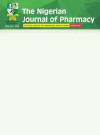In Vitro Antiproliferative And Antioxidant Assessment Of The Extract And Partitioned Fractions Of Leaves Of Euphorbia Graminea Jacq. (Euphorbiaceae)
Keywords:
Cytotoxicity, Growth Inhibitory, Euphorbia graminea, Antiproliferation, Antioxidant, Breast Cancer Lines (MCF-7), Lung Cancer (NCI-H460), Cancer CellsAbstract
Background: Euphorbia graminea Jacq. (Euphorbiaceae) is a medicinal plant with limited information on its biological applications and reported scientifific studies.
Method: This work was aimed at investigating the in vitro antiproliferative and antioxidant effffects of leaf the extract and fractions of E.graminea by employing the Sulforhodamine-B as well as the DPPH-RSA(2, 2-diphenyl-1-picrylhydrazyl) assays respectively. The extract and fractions of E. graminea displayed growth inhibitory and cytotoxic effffects in a concentration dependent manner on the cell lines.
Results: At 250 µg/ mL, the extract recorded -3.1 and +75 % cytotoxic and growth inhibitory effects on MCF-7 and NCI-H460 cell lines. While the cytotoxic effffect became more pronounced on MCF-7 cell lines as -2.19 and -9.6 % cytotoxicities were recorded by the chloroform fraction at 75 and 100 µg/ mLthe ethyl acetate fraction recorded +58.72 and +89.33 % inhibitory effffects at similar concentrations. The hexane and ethyl acetate fractions were inactive against NCI-H460 cell lines at all concentrations. The antioxidant activities further corroborated the antiproliferative activities as IC50 of 58.88 µg/mLwas recorded by the chloroform fraction against 46.77 µg/mLby Quercetin.
Conclusion: This work has shown that the antiproliferative and antioxidant activities of E.graminea resides more in the chloroform phase and could be due to the active metabolites it contained. In continuation of this work, the Isolation and characterization of some of these metabolites will thus be carried out.
References
Aigbokhan E I and Ekutu O (2012). Aspects of the Biology and Ecology of Euphorbia graminea Jacq.
(Euphorbiaceae) – a Potentially Invasive Herbaceous Plant in Nigeria. Nigerian Journal of Botany; 25 (1): 35 – 53.
Lowe J. (1995). Recent records of flowering plants in Nigeria. The Nigerian Field; 60: 42-51.
Edeoga HO, Okwu DE and Mbaebie BO (2005). Phytochemical constituents of some Nigerian
medicinal plants. African Journal of Biotechnology; 4(7): 685-688.
Betancur-Galvis LA, Morales GE, Forero JE and Roldan J (2002). Cytotoxic and Antiviral Activities of
Colombian Medicinal Plant Extracts of the Euphorbia genus. Memórias do Instituto Oswaldo Cruz; 97 (4): 541-546.
Alonso-Amelot, ME, Arellano E, Avila JL, Aubert L, Romero R., Calcagno MP, Avendaño M, Perez M and
Otero LD (2004). Asurvey of Venezuelan plants toxic to livestock and their potential as anti-insect
materials. In: Acamovic T, Stewart CS and Pennycott TW. (eds.) Poisonous plants and related toxins. CABI. Wallingford, pp 471-477.
USDA ARS. (2010). National Genetic Resources Program. Germplasm Resources Information Network - (GRIN). [Online Database] National Germplasm Resources Laboratory, Beltsville, Maryland. Available: http http://www.arsgrin.gov/cgibin/npgs/html/ taxgenform.pl?language=en [Accessed 24 May 2020].
McVaugh R. (1993). Euphorbiae Novo-Galicianae revisae. Contrib. Univ. Michigan Herb, 19: 207–239.
Sofowora A (2008). Medicinal Plants and Traditional Medicine in Africa. 3rd Edition.
Skehan, P, Storeng R, Scudiero D, Monks A, McMahon J, Vistica D, Warren J.T, Bokesh H, Kenney S and Boyd MR (1990). New colorimetric cytotoxicity assay for anticancer-drug screening. Journal of the National Cancer Research Institute 82(13):1106-1112.
Singleton VL, Orthofer R. and Lamuela-Raventos, RM (1999). Analysis of total phenols and other
oxidation substrates and antioxidants by means of Folin-Ciocalteu reagent Methods. Enzymol; 299:
-178.
Thamaraiselvi P, Lalitha P, Jayanthi P (2012). Study of antioxidant activity of ethanolic extract of fresh Eichhornia crassipes (Mart.) Solms. Der Pharmacia Sinica; 3(2):271-277.
Desmarchelier C, Bermudez MJN, Coussio J, Ciccia G and Boveris A (1997). Antioxidant and prooxidant activities in aqueous extract of Argentine plants. International Journal of Pharmacognosy;
:116–120.
Beaglehole R, Bonita R and Horton R (2011). Priority actions for the non-communicable disease crisis. The Lancet; 377(9775) :1438–1447.
Partridge AH, Burstein HJ, Winer EP (2001). Side effects of chemotherapy and combined chemohormonal therapy in women with early-stage breast cancer. Journal of the National Cancer
Institute Monograph; 30:135-142.
Dai J and Mumper RJ (2010). Plant Phenolics: Extraction, analysis and their antioxidant and anticancer properties. Molecules; 15: 7313- 7352.
Lobo V, Patil A, Phatak Aand Chandra N (2010). Free radicals, antioxidants and functional foods: impact on human health. Pharmacognosy reviews; 4(8):118–126.
Cho M, Lee HS, Kang IJ, Won MH and You S (2011). Antioxidant properties of extract and fractions from Enteromorpha prolifera, a type of green seaweed. Food Chemistry ;127(3):999-1006.
Jung MJ, Heo SI, Wang MH (2008). Free radical scavenging and total phenolic contents from methanolic extracts of Ulmus davidiana. Food Chemistry; 108:482–7.
Badgujar NV, Mistry KN, Rank DN, and Joshi CG (2018). Antiproliferative Activity of Crude Extract
and Different Fractions of Butea monosperma Against Lung Cancer Cell Line. Indian Journal of
Pharmaceutical Sciences, 80:875-882.
Vafaee K, Dehghani S, Tahmasvand R. (2019). Potent antitumor property of Allium bakhtiaricum extracts. BMC Complementary and Alternative Medicine; 19(1):116-121

Published
How to Cite
Issue
Section
License

This work is licensed under a Creative Commons Attribution-NonCommercial 4.0 International License.


